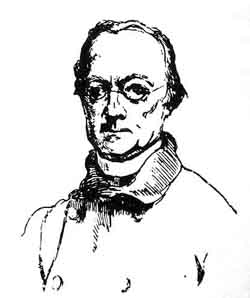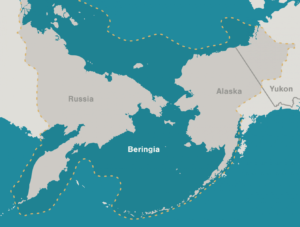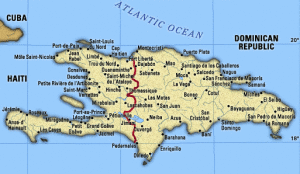Paul Felix Cabrera
Bering Strait *
The Bering Strait between Asia and America has been a source of ongoing controversy regarding the peopling of America.
James Howell (1594-1666) relates how even in the 17th century the existence of the strait, then known as the Anian, was disputed, although, at the same time, there was also a theory that the nomadic Scythians had originally crossed over the Strait from America[1313].
In 1985, Nicholas Flemming published an article(y) in the Woods Hole Oceanographic magazine Oceanus in which he touched on the matter of the Bering Strait. “There was dry land from Siberia to Alaska, the Bering Land Bridge, for most of the time from 80,000 to 14,000 years ago. Shallow episodes of flooding occurred at about 45,000 and 35,000 B.P Cores from the land and the sea bed provide evidence for the pollen types at different dates, the sediment movements, and the stages of marine transgression or emergence. From the point of view of human occupation, the inhospitable nature of Beringia was not just because of the cold, but also the severe dryness for most of the time from 60,000 to 14,000 B.P.” Contrast this with the next paragraph.
A 2022 report of “A new study that reconstructs the history of sea level at the Bering Strait shows that the Bering Land Bridge connecting Asia to North America did not emerge until around 35,700 years ago, less than 10,000 years before the height of the last ice age (known as the Last Glacial Maximum).”(x)
By the end of the 18th century, the importance of the Strait had been recognised, when Paul Felix Cabrera wrote “That most troublesome of all the difficulties hitherto started by authors respecting the passage of animals to America, particularly of the ferocious kinds at enmity with man, even retaining in full force the plausible reasons so ingeniously urged, if not entirely removed, is nearly surmounted by the discovery and examination of Anian or Behring’s straits’ which are of no greater breadth than thirteen leagues from shore to shore, and where, by means of the ice, the two continents of Asia and America are connected; this would afford a practical route not only for animals but men, from whom it is possible to suppose that those who inhabit the most northerly countries from the straits as far as Hudson’s and Baffin’s Bays, and from the Frozen Sea to California, New Mexico, and Canada to the southward, are descended.” (s)
In certain circumstances, it is still possible to walk across the Bering Strait. “A 2.5-mile stretch divides Russia’s Big Diomede island from Alaska’s Little Diomede island. In the winter, the water separating the two islands freezes, allowing you to trek from one destination to the other.”(n) Wikipedia notes that “numerous successful crossings without the use of a boat have also been recorded since at least the early 20th century.” (o)
There is little doubt that at some point in prehistory a landbridge linked the two continents.
Although it is frequently claimed that the Hadji Ahmed Map of 1559 shows a landbridge between the two continents, it only appears to be so because of the way the map is drawn.
A recent paper(a) by Heather Pringle and Krista Langlois offers evidence that the link was more than just an isthmus but was in fact a vast area of land, Beringia, the size of Australia, and that it provided a crossing point, for humans and animals earlier and for longer than previously believed (See map above right).
 After crossing the Strait there were two southward routes, one along the coast and the other via what is known as the Ice-Free Corridor Route which ran between two vast ice sheets, the Laurentide to the east and the Cordilleran to the west(c). According to a 2018 report(i), the coastal route which followed deglaciation “was physically and environmentally viable for early human migration to the Americas.” Another report in 2018 claims that the earliest settlers in America were island-hopping seafarers from Asia(j)(k).
After crossing the Strait there were two southward routes, one along the coast and the other via what is known as the Ice-Free Corridor Route which ran between two vast ice sheets, the Laurentide to the east and the Cordilleran to the west(c). According to a 2018 report(i), the coastal route which followed deglaciation “was physically and environmentally viable for early human migration to the Americas.” Another report in 2018 claims that the earliest settlers in America were island-hopping seafarers from Asia(j)(k).
However, there is now compelling evidence that people reached South America before the existence of the northern ice-free corridor, suggesting the alternative coastal migration route, which, so far, has little evidence to support it. This recent report is the result of excavations at the Huaca Prieta ceremonial mound, 600 Km north of the Peruvian capital, Lima. Human activity there has now been dated to around 15,000 years ago(e). Further evidence has now emerged(p) that the peopling of America was not carried out by a single group, but by immigrants from different geographical areas.
Professor Jody Hey of Rutgers University published in 2011 the results of his North American DNA studies, which confirmed the arrival of the first migrants from Asia around 14,000 years ago in a group of not more than 70 people(r).
Pre-Columbian contact between Asia and Alaska was confirmed by a report(b) from Purdue University in September 2016. artefacts were discovered in a house dated between 700 and 900 years old. The bronze items were identified as having been smelted in Asia, while a leather strap was radiocarbon-dated to between 500 and 800 years old.
Another 2016 report(d) added genetic evidence for the Beringia migration route, when the remains of two infants, dated to around 10,000 years ago were discovered at the Upward Sun River site in Alaska.
Further supportive evidence of the use of the Beringia landbridge was uncovered at Alaska’s Swan Point site where human occupation has been dated as far back as 14,000 years ago. “Another notable aspect of Swan Point is the role it has played in understanding the prehistoric migration of peoples into the Americas. A type of stone tool, the microblade, which was unearthed at the site, has been found to resemble those used by the Dyuktai people, who lived in Siberia around the same period. This shows that people crossed from Siberia to Alaska on the Beringia land bridge.”(t)
The ‘received wisdom’ regarding the origins of the Clovis people was that they had crossed into the Americas from Asia via the Bering Strait 12,000 years ago. This has been challenged in a book[1516] by two archaeologists, Dennis J. Stanford and Bruce A. Bradley, who claim “that the first Americans crossed the Atlantic by boat and arrived earlier than previously thought. Supplying archaeological and oceanographic evidence to support this assertion, the book dismantles the old paradigm while persuasively linking Clovis technology with the culture of the Solutrean people who occupied France and Spain more than 20,000 years ago.” In 2014, Stephen Oppenheimer endorsed the work of Stanford and Bradley(h). Coincidentally, an article(m) in the August 2017 edition of Antiquity offers evidence that humans lived in Brazil more than 20,000 years ago, which is many millennia before the Clovis people arrived in North America.
A sceptical view of their work should also be read(f). Furthermore, in 2016 the Solutrean Hypothesis also appears to have been contradicted by recent genetic studies(g).
Late August 2019 saw the dating controversy surrounding the arrival of the First Americans re-ignited with a study that pushes the date back to over 16,000 years ago(l). This is based on archaeological discoveries at Cooper’s Ferry in Idaho. This earlier date suggests that the ice-free corridor would not have been available to these people, but are more likely to have used the coastal route from Asia via the Bering Strait. A secondary matter raised by these finds is that “Based on their analysis of the stone tools from Cooper’s Ferry, the researchers suggest that they are most similar to artifacts of the same general period found on the other side of the Pacific. Specifically, they appear to share many traits with tools produced on the northern Japanese island of Hokkaido 13,000-16,000 years ago!”
The idea that the Clovis people were the first Americans is gradually losing support as the evidence found at Cooper’s Ferry and other sites indicates otherwise. A recent paper on the National Geographic website supports such a revised view(q).
Itztli Ehecatl published a two-part paper(u)(v) on the Atlantisforschung website denouncing the Bering Strait theory with the complaint that “Although some archaeologists have good intentions, most do not want to consider that Native Americans preserved an ancient history in their oral traditions. The unwillingness to reach a compromise between archaeological and indigenous knowledge is a tragedy that the discipline should work hard to overcome, otherwise, archeology will perpetually rely on flawed data.”
Michael Collins, a Texas State University archaeologist, is one of a number of academics who question whether the Bering Strait was the route used by the First Americans. Although the theory has been generally accepted for at least a century, support is weakening in the face of mounting evidence. An article in the journal Archaeology(w) (Aug.10, 2014) reports on Collins’ evidence up to that date.
It was depressing to read that ” the few scholars who dared challenge the Clovis lace theory on the basis of solid evidence were furiously ostracized and their careers destroyed. In 1951 Dr. Thomas Lee, working at the National Museum of Canada, identified a site in Sheguiandah, Canada. When the site was analyzed it was dated between 30,000 and 100,000 BP. Because his work conflicted with accepted Clovis doctrine, the museum he had worked for fired him, and his records of the finds were mysteriously stolen. Lee explained that both Canadian and American scholars blacklisted him and enforced an eight-year professional ban on him.” This period also saw the academic arrogance that Velikovsky had to endure in the USA.
The first direct connection of the Bering Strait with Atlantis has been suggested by Albert. M. Chelchelnitsky, who proposed that Atlantis had been situated in Alaska and placed the Pillars of Herakles in the Strait itself.
More recently, Michael Szymczyk, the author of Atlantis & Its Fate In The Postdiluvian World [1964], in which, like Chelchelnitsky, he makes some extraordinary claims without providing any evidence. He pinpoints an underwater site near Kodiak Island off the northwest Pacific coast of Alaska as the location of Atlantis!
(a) https://www.hakaimagazine.com/article-long/sunken-bridge-size-continent
(h) https://www.tandfonline.com/doi/abs/10.1080/00438243.2014.966273?journalCode=rwar20
(j) Boulder-Size Clues to How Humans Settled the Americas – The New York Times (archive.org)
(k) https://gizmodo.com/humans-may-have-reached-north-america-by-more-than-one-1828194893?lR=T
(m) https://www.sciencenews.org/blog/science-ticker/stone-age-people-brazil-20000-years-ago
(o) https://en.wikipedia.org/wiki/Bering_Strait
(q) https://www.nationalgeographic.com/culture/2019/08/coopers-landing-idaho-site-americas-oldest/
(s) https://olivercowdery.com/texts/1822DRio.htm
(w) https://www.archaeology.org/issues/150-1409/features/americans
(x) Bering Land Bridge formed surprisingly late during last ice age, study finds – Search (bing.com)
(y) https://www.academia.edu/21168111/Ice_Ages_and_Human_Occupation_of_the_Continental_Shelf
Brasseur de Bourbourg, Charles Etienne
Charles Etienne Brasseur de Bourbourg (1814-1874) was born in  Bourbourg, near Dunkirk, France. He entered the priesthood and in 1845 he left for Canada and was for a short time professor of ecclesiastical history at Quebec. He worked as a missionary in Mexico and Central America where he developed an intense interest in the native South Americans and their origins. In 1859 he published a history of the Aztecs.
Bourbourg, near Dunkirk, France. He entered the priesthood and in 1845 he left for Canada and was for a short time professor of ecclesiastical history at Quebec. He worked as a missionary in Mexico and Central America where he developed an intense interest in the native South Americans and their origins. In 1859 he published a history of the Aztecs.
Hubert H. Bancroft (1832-1918), the American historian, noted[1319.125-132]+ that initially, Brasseur was highly sceptical of the reality of Atlantis, but as his studies deepened he became an enthusiastic believer.
Brasseur de Bourbourg’s ability to track down rare manuscripts was legendary. In 1865, he discovered some of Bishop Diego de Landa‘s lost documents. He studied the thoroughly flawed interpretation of Mayan hieroglyphics by de Landa, produced in the 16th century and proceeded to develop his own faulty translation. While working on the Maya texts, he thought he had discovered the word Mu, which he claimed was the name of an inundated land with other features similar to Atlantis and proposed that they were the same. He wrote copiously on this association, without any real evidence except his own deluded ideas.
He concluded that the Maya were originally from Atlantis, based on Plato’s description of Atlantean culture. This view was expressed in his 1868 book, Quatre Lettres sur le Méxique[1450]+.
In an 1866 offering[1506]+, he recorded his study of the Mayan monuments, particularly Palenque. The illustrations for this book were executed by Jean-Frédérick de Waldeck.
Brasseur also translated local languages into Roman script and perhaps his most important contribution was a French translation of the Popul Vuh, the sacred book of the Quiché branch of the Maya, which was published in 1861. An English translation is now available on the Internet(a).
Nigel Davies has revealed[1635] that Brasseur, as well as Lord Kingsborough (1795-1829), concluded that the native Americans were the Ten Lost Tribes of Israel. Kingsborough spent a £40,000 fortune publishing The Antiquities of Mexico in nine huge volumes, an extravagance that landed him in a Dublin debtor’s prison for non-payment of bills relating to publication costs and sadly, he died there.
This idea of the Lost Tribes in America had been suggested centuries earlier by Diego de Landa (1524- 1579), the Franciscan bishop of Yucatán.
In the mid-19th century, Brasseur proposed that Atlantis had existed on a large landmass in the Atlantic of which Hispaniola is a remnant. He believed that this vast peninsula extended to the vicinity of the Canaries. This idea was based on his own, largely incorrect, interpretation of Mayan glyphs. The American Hyde Clarke and the Guatemalan doctor Paul Felix Cabrera shared similar location theories.
Jason Colavito has pointed out that Brasseur was probably the first to suggest the possibility that some form of Pole Shift led to the destruction of Atlantis(b). This idea was published in 1873 and is available in an English translation by Colavito(c).
After what he thought was a reference to a flooded land called Mu, one of his last conclusions was that Mu and Atlantis were the same and that Mu was the correct name for the flooded land. This fantasy led Augustus le Plongeon to revise this theory, suggesting that refugees from both Mu and Atlantis were the founders of the Mayan civilisation.
[1319.125-132]+ https://archive.org/details/nativeraces05bancrich (Vol.V) *
[1450]+ https://archive.org/details/quatrelettressur04bras *
[1506]+ http://gallica.bnf.fr/ark:/12148/bpt6k130466g *
(a) https://www.meta-religion.com/World_Religions/Ancient_religions/Central_america/popol_vuh.htm
(c) https://www.jasoncolavito.com/historical-chronology-of-the-mexicans.html
Cabrera, Paul Felix
Paul Felix Cabrera was an 18th century Guatemalan doctor who proposed in 1796>“that Septimania is, beyond a doubt, the island Atlantis or Hispaniola”<and that the Phoenicians had settled the Caribbean and Mesoamerica. He also claimed that the ruins at Palenque are support for this assertion. The entire text is available on-line at the Oliver Cowdery link below(a) .
Andrew Collins maintains that Cabrera‘s ‘theories’, although revolutionary, were flawed by political bias against neighbouring Cuba. Collins supports a Cuban location for Atlantis(b) .
Hispaniola*
Hispaniola is the second largest island in the West Indies, containing Haiti and the Dominican Republic. Before Columbus, Hispaniola was known by the locals as Quisqueya – Mother of the Lands. It is sometimes spelt Kiskeya.
In 1794 a Guatemalan doctor and scholar, Paul Felix Cabrera, proposed that Hispaniola was Atlantis as well as a mysterious Atlantic island called Septimania. However, his theories, although revolutionary, were flawed by political bias against neighbouring Cuba. In the mid-19th century, Charles Etienne Brasseur de Bourbourg was another who proposed that Hispaniola was in fact a remnant of Plato’s Atlantis. In 1885 the American historian, Hyde Clarke, also suggested Hispaniola as a possible location.
The most recent advocate is Prof. Emilio Spedicato who proposes(a) the island as the home of Atlantis and contends that a consideration of the topography of Hispaniola suggests that the ruins of the capital city, if not completely destroyed by the catastrophic event (most probably a huge tsunami due to either an oceanic impact of a comet or an Apollo object or to the tidal effects of a planet passing close to the Earth) lie under thick sediments in the bottom of Lake Henriquillo, close to the southern coast of Santo Domingo, near the border with Haiti.
In January 2010 an archaeologist, Fianchy Torres, claimed(b) that a site in Manzanillo Bay in the northwest of the Dominican Republic, near the Haitian border, was the location of Plato’s Atlantis(c). He based his contention on anomalies he found on Google Earth images and sea level changes. Similar underwater anomalies have been identified in Peru, near Puerto Rico as well as the Canaries, which appear to be the result of data processing errors.
The idea of Atlantis in Hispaniola, inspired by the work of Spedicato, is now supported by the Kiskeya-Atl Research Center(d), which has announced that it will host a three-day conference in November 2018, with an invited panel of “renowned scholars and researchers on the topic.” Hervé Fanini-Lemoine, is one of the founders and current chairman of the Research Centre. Its purpose “is to research and find artefacts to sustain the hypothesis which says the lost land of Atlantis is, in fact, KU-ISH-KU-EYA, ‘Mother of Lands'”.
Andrew Collins who proposes Cuba as the location of Atlantis has offered a critical response to Spedicato’s Hispaniola theory in both Gateway to Atlantis and its revised version Atlantis in the Caribbean.
(a) https://www.academia.edu/10973532/ATLANTIS_IN_HISPANIOLA_
(d) Kiskeya Atl Research Center – Overview, News & Competitors | ZoomInfo.com (link broken) *


